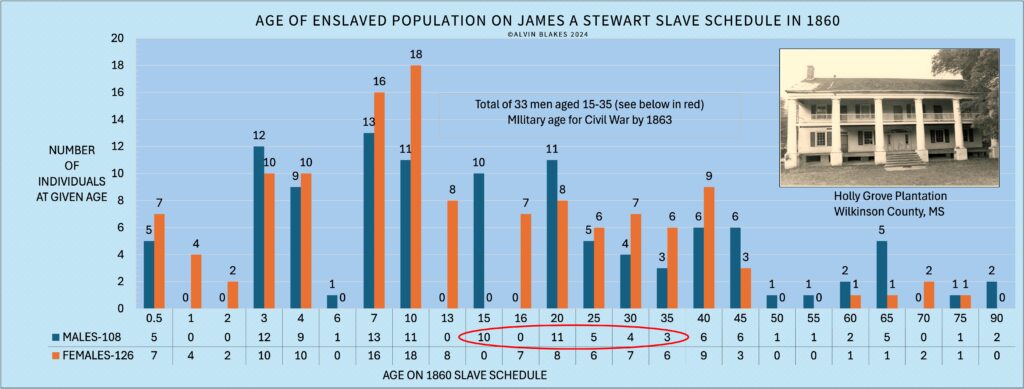The William Veal of So Red the Rose is a fictional person, but no doubt his character is appropriated from the real-life William Veal of Holly Grove Plantation in Wilkinson County, Mississippi. In the novel, he is imagined as a loyal family servant, a defender of the slave owners, and their view that they were superior to enslaved African people–who were a tier below them as humans, therefore born to serve. My purpose in introducing So Red the Rose in this blog series was not to review or critique the book but to use it as a backdrop of how enslaved people have been written about in American literature. In fact, as was once my own case, much of the prevailing written history makes us shy away from researching our own family history—as losers, slimy servants, and ungrateful malcontents.
Our enslaved ancestors were not superheroes or super servants as depicted in books and movies—they were neither bad-asses like Django (Unchained) nor the despicable house servants like Stephen. They were forced and coerced to work as enslaved people, but they resisted in various ways and when the opportunity came they fought and won the right to full humanity as free people. The Civil War was fought over the Confederacy’s desire to continue slavery – an evil system that provided free labor. wealth. and leisure to the ruling class. It reinforced and perpetuated the inferiority of other people under a system that both exploited their humanity for economic gains and championed white supremacy in all its forms.
I have uncovered only a few details of the life of William Veal and Mary Brent Veal in the records, and there is no family oral history that has been passed down to me. The fact that their family and plantation community supplied fighting men to the Civil War Union army, at a time when they were most needed, clarifies their lives during this time in history. Their contribution to the freedom and the building of our communities should be known and recognized.
If the Emancipation Proclamation of January 1863 freed the slaves, why did they have to “run away”? This is the term that appears repeatedly in the Pension files. When presented with the opportunity to join the fight they answered the call. In the 1860 Census “slave schedule” of James A Stewart there were 234 enslaved people in 60 cabins on Holly Grove Plantation – 126 females and 108 males. Of those 108 males, around 33 would have been between the ages of 17-35 by 1863, and eligible to join the fight. So far, I have identified many of those on Holly Grove who enlisted in the Union Army and Navy. Why did so many of the military age men from Holly Grove plantation join the fight when other nearby plantations had only a few who joined, and some had none? This question is one I will take up at another time.

By studying the Pension files and military records of the immediate family of William Veal and a host of cousins and other connected family on Holly Grove, I can see a bigger story that still has not been told. It is the story of the thousands of young black men all over the enslaved plantations along the Mississippi River, dropping their hoes in the fields — or in some cases, their serving trays in the house, and joining the fight for their own freedom. The story of the 180,000 Black soldiers in the United States Colored Troops and the 18,000 Black sailors in the Union Navy comes into better focus through the stories of Frederick Alexander, Madison Veal, and Noland Veal.
It is of great importance in our historical narrative to know that at the pivotal moment between slavery or freedom, we chose to join in the fight for our freedom. That those who were of military age in the plantation communities throughout the South answered the call of Frederick Douglass and others and ran toward the battlefields. Meanwhile, those who stayed behind on the plantations supported them so that when they returned they could begin to build a new life. May they always be remembered.

Amen!
The pension files tell a story not found elsewhere. Invaluable resources.
Thanks for reading.
Redemption song for for our self emancipated (runaway) by the thousands upon thousands all over the south when the white men in the blue coats and the gray coats went to uncivil war over chattel slavery systems! Able bodied Enslaves deliberately volunteered to join in the fighting as the third army on the side of the United States Army. They decisively helped to defeat the confederate army! Thus, gaining their freedom, the freedom of other enslaves and making it possible for the enactment of the first mass civil rights in the history of the United States. That was the 13, 14 and 15 amendments to the United States Constitution! They won “the double victory” of freedom from chattel slavery and helping to save the Union of the United States of America!
Alvin, my person have copies of U. S. Afrikans descent civil war freedom fighters that talks about self emancipated enslaves in the run from Wilkinson County Mississippi to Freedom at the Union army occupation in Freedom City Natchez, who were ambushed and shot and wounded, therefore they did not make it to Natchez Union army freedom then! But William Veal and them did and made the human throw down fighting that made freedom ring!
Ser, I will be in touch with you to review the documents.
Alvin you’re doing some important detective work as you uncover these stories making the case for research being key to our historical relevance. If we don’t tell our stories they will most certainly be erased especially given the current political climate.
Thanks Vicki.
Alvin, what can be extracted and developed from just a “few details” on William & Mary Veal?! We will forever salute those field workers-warriors who enlisted in the USCT and Navy, both researched and unrecognized. But thanks for the last two sentences that resonate so with the accounts of my Rutherford County, North Carolina ancestors.
Thanks Diana. That’s good news that my family history is transportable to your North Carolina family’s historical situation.